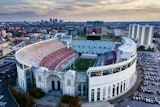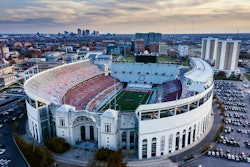How do you stop one outraged neighbor from scuttling your public recreation project?

Any quality-of-life survey in any town across the United States will typically rate parks and recreation programs and facilities among the most valued services and amenities local governments can offer. Citizens expect a full menu of recreation activities for everyone in the family, from preschoolers to grandparents. More often than not, they eagerly support the use of tax dollars to finance traditional facilities (playgrounds, bike paths, outdoor pools, nature preserves and soccer complexes) and even nontraditional ones (skate parks). Many growing communities actively acquire green space through a regulatory planning and zoning process based on calculated formulas of population size and density.
This emphasis on quality-of-life amenities and the expectation that government will deliver them is in part a result of the coming of age of baby boomers who grew up in the suburbs that flourished in the 1950s and '60s. The boom economy of the 1990s gave elected officials the opportunity to fulfill demands by focused-interest groups for more ball fields and more preservation areas.
What makes it so hard to see these projects to fruition?
The problem is the emergence, in the latter half of the 20th century, of several mutant variations of citizens, all of whom feel an overwhelming need to speak loudly in public forums. One of the most common subspecies is known as the NIMBY (an acronym for Not In My Back Yard), who takes great liberty in defining the boundaries of his or her backyard. A related group are the BANANAs (Build Absolutely Nothing Anywhere Near Anything). Both believe their mission is to save their community from life-threatening, property-devaluing dangers, and they employ a variety of methods to make their point.
It is important to distinguish NIMBYs and BANANAs from those citizens who actively participate in and positively contribute to local government. It is an exception to the rule when no one expresses a contrary opinion to the initial plan for a project. The best projects are the result of many ideas from many sources. Public participation during the planning process is essential to ensure the project evolves in a way that responds best to available capital and to those being served, whether they are a specific neighborhood, focused-interest group or the entire tax base.
The rantings and antics of NIMBYs and BANANAs, on the other hand, are legend, and have become urban tales to be repeated again and again. Whenever public administrators gather at regional meetings or national conferences, they swap stories about the outrageous behavior they have witnessed in public meetings, or the relentless Letters-to-the-Editor campaigns that have targeted them.
NIMBY and BANANA complaints inevitably center on one specific (and to them, inevitable) outcome: The new park or recreation facility will destroy the neighborhood's quality of life (because of light spillage from nighttime play at outdoor fields, increased automobile traffic or the intrusion of "undesirables" into the neighborhood), and thereby lead to plummeting house values. This, of course, is false in most cases. While certain public improvements can adversely affect quality of life, parks and recreation facilities don't. A 2000 study commissioned by the East Bay Regional Park District in Oakland, Calif., for example, concluded that the district's presence is a major factor in the economic prosperity of the area it serves. The study demonstrated that properties adjacent to parks and trails derived up to 30 percent of their value from their proximity to green space.
Even in cases (like this one) where the benefits to property owners are identifiable and quantifiable, NIMBYs and BANANAs often resort to melodramatic tactics to make their point. One often-cited command performance (although this time supporting the cause of public recreation) featured a group of sobbing women wrapped together in yellow "POLICE LINE" tape insisting to their city council that a small development of homes next to an elementary school and outdoor pool (and the resulting increase in traffic) would put their children's lives in certain jeopardy. (Unmoved, the council allowed the development to continue.)
Others take the NIMBY moniker literally. One such case involved a NIMBY who purchased a home in a new development along a stream, with the knowledge that a planned bike path would follow the stream corridor across the extreme outer edge of each home's back yard. It was soon found, however, that the combination of the NIMBY's irregularly sized lot and a bridge bringing riders across the stream would make it necessary to curve the bike path further into his lawn. The NIMBY refused to grant an easement, even though this made it necessary to cant the bridge across the stream at an angle that delivered the bike riders directly into the NIMBY's backyard at a 90-degree angle. The city offered to enhance the landscaping along the bike path and bridge abutment to appease the resident. Again, he refused. Within days of the bridge's completion, it became apparent to the NIMBY what had been obvious to the parks department all along - the sharp turn of the bike path from the bridge sent many bike riders hurtling into the NIMBY's backyard. His subsequent letter to city hall declared his intention neither to give first aid nor to call emergency services on behalf of anyone injured on his property.
NIMBYs are, above all, extremely sensitive to noise. One couple tried to stop a community center expansion because they were annoyed with the squeaky swings at the playground. The park, the community center and the athletic fields had all been well-used for many years. As neighbors, they were invited to all the public meetings about the project. Their continual complaint was the intrusion of their privacy by the noise, conversation and children's laughter from the playground located 300 feet from their house. Between the park vegetation and the neighbor's backyard landscaping, a fairly opaque screen was achieved during the summer. The plan incorporated enhanced evergreen landscaping, and still they disagreed. The expansion's eventual design was thus driven by the need to avoid audible and visual connection with this particular home. Windows were placed in strategic locations so the neighbors could not see the walkers on the mezzanine-level track - that is, so the walkers could not see into the NIMBYs' house, another of their (there is in this instance no other phrase for it) farsighted objections.
The one recreational area that is often able to withstand NIMBYism is the passive park. In many cases, parks are added or expanded to mollify NIMBYs who fear residential development (or further development) in their neighborhoods. For example, a new neighborhood's sewer system was reaching capacity, and needed to expand. The next subdivision to be rezoned became the last straw for the "No Growthers," a loosely organized contingent of NIMBYs who had been pro-growth back when they moved in.
This group's mission was to close the borders of the community. This was a fairly forward-thinking community, with a stringent green-space ordinance in place that required about 10 percent of all newly developed property to be set aside for parks. The NIMBYs, though, demanded more in this case, and refused to allow any more homes to be built until their sewer system was improved. They financed lawyers and environmental experts to plead their case to prevent growth - not realizing, of course, that many of their neighbors had taken similar actions when the new NIMBYs' subdivision was approved three years earlier.
The standoff lasted throughout the summer, with each public meeting further inflaming both the developers and the NIMBYs. Ultimately, a deal was struck - the subdivision would be approved with many more acres of parkland than were required by the local ordinance, with the stipulation that the park would forever be a nature preserve jointly developed for the benefit of the residents and schoolchildren. It would probably not surprise anyone to learn that although the community clearly won, the NIMBYs continued to complain afterward - this time questioning the long-term wisdom of setting aside such a large parcel of potentially valuable property.
Not all encounters with NIMBYs end with the proposed project going forward in one manner or another. Elected officials and decision-making bodies often are swayed by the hue and cry of these protest groups and strike the project off the capital-improvements list. The opportunities for some projects are lost forever, while it may take decades for the original intent of others to be achieved. Fortunately, elected officials' terms and appointments do eventually come to an end, whether via the voters or by legal statute. Unless circumstances have completely changed, defeated projects and shelved ideas - good or bad - often resurface about every 10 years.
The very approach that gives NIMBYs and BANANAs their opportunity to act out also is the best forum to defuse their often-irrational outbursts. A well-managed public and open process for determining the priority of possible projects and allocation of funds is the most important step to foster an environment that promotes lively dialog and debate. By encouraging the involvement of residents and businesses in local government decisions, the best direction for the entire community usually becomes readily apparent. Those who espouse dramatically divergent views and those who repeat the same theme over and over are frequently - although oftentimes unjustifiably - dismissed as not contributing to the common interest of the community.
Minimizing the negative impact of a NIMBY-contested project can be approached several ways. From the very beginning of the capital endeavor, share public information about the project with both residents and official decision-makers. A well-publicized process will allow the project's real issues to surface and demonstrate to the public and the news media genuine efforts to solve problems. Establishing a relationship with the news media as a credible and responsible public servant is helpful, as it counters the common NIMBY tactic of waging the battle in the newspapers and on TV. When presenting the future project in any public forum, frame it in a benefits-based format, emphasizing the value to individuals, the community, the environment and the local economy.
Once NIMBYs have made their presence known, invest your time and energy toward understanding their issues. Make the effort to meet with them face to face - on their turf, at their convenience - and listen. Utilize an active-listening technique, such as repeating to them what they have told you. This demonstrates that you are validating their right to voice their concerns, but not necessarily agreeing with their position. Document your meeting, and the items discussed. This can be helpful down the road, when the process is not going their way and you are accused of ignoring them.
Through formal and informal lines of communication, determine who the advocates for the project are among the various public boards, commissions and elected officials. Keep these people well-informed about any encounters with NIMBYs, as these are the professionals best equipped to move the project forward. Compiling a one-page fact sheet with issues and answers is a tool that ensures that correct information is being disseminated by all - misinformation being another common NIMBY tactic. Finally, consider a time limit for comments at public meetings. This discourages the heated diatribes that end up as headlines and sell newspapers.
Although not always pleasant participants in the planning of recreation projects, NIMBYs and BANANAs are members of the community and deserve the same considerations as any citizen. Their quality-of-life issues are as important to them as they are to those who embrace the park across the street or the bikeway system through their backyard. They challenge us to thoroughly think through ideas and comprehensively plan the future - and sometimes, they just might improve a project in their own weird way.




































